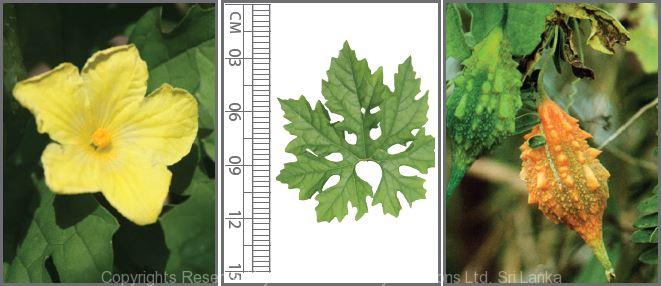

Traditional Knowledge
Useful plant parts :
Fruit and root
Uses in traditional medicine :
- Fresh fruit juice is taken to decrease the blood glucose level in diabetic patients
- Roots are aphrodisiac
- Roots are used to treat haemorrhoids
- Fruits and leaves are used as a vermifuge and for treating piles
Scientific Research
Chemical constituents:
Bitter and non-bitter cucurbitane triterpene aglycones and their glycosides: momordicosides K and L, kuguaosides A–D, momordicines I and II and steroidal saponin: charantin, monoamine: serotonin from plant; terpenes: trans-nerolidol, cis-dihydrocarveol, germacrene D and apiole from seeds; a mixture of acylglucosylsterols from green fruits; haemagglutinating lectin from seeds
Bioactivity :
Fruit peel: chemopreventive, lipid lowering effects in HIV-1-protease inhibitor treated human hepatoma cells; fruit extract: hypoglycaemic, hypocholesterolaemic, hypolipidaemic; seed proteins: antiviral
Clinical:
Aqueous fruit extract shows hypoglycaemic effect in diabetic patients
Note :
Fruits are used as a vegetable
References : Arinantenaina, L. H., (2006), Momordica charantia Constituents and Antidiabetic Screening of the Isolated Major Compounds, Chemical & Pharmaceutical Bulletin, 54(7) 1017—1021. Barbieri, L. et al., (1980), Inhibition of protein synthesis in vitro by proteins from the seeds of Momordica charantia (bitter pear melon), Biochem J, 186(2), 443–452. Braca, A. et al., (2008), Chemical composition and antimicrobial activity of Momordica charantia seed essential oil, Fitoterapia, 79(2), 123–125. Fernandes, N. P. et al., (2007), An experimental evaluation of the antidiabetic and antilipidemic properties of a standardized Momordica charantia fruit extract, BMC Complement Altern Med, 7(29). Guevara, A. P. et al., (1989), Acylglucosyl sterols from Momordica charantia, Phytochemistry, 28(6), 1721–1724. Hsiao, P. C. et al., (2013), Antiproliferative and hypoglycemic cucurbitane-type glycosides from the fruits of Momordica charantia, J Agric Food Chem, 61(12), 2979-86. Matsui, S. et al., (2013), The hypocholesterolemic activity of Momordica charantia fruit is mediated by the altered cholesterol- and bile acid-regulating gene expression in rat liver, Nutr Res, 33(7), 580-5. Nerurkar, P. V. et al., (2006), Lipid lowering effects of Momordica charantia (Bitter Melon) in HIV-1-protease inhibitor-treated human hepatoma cells, HepG2, British Journal of Pharmacology, 148(8), 1156-1164. Pongthanapisith, V. et al., (2013), Antiviral Protein of Momordica charantia L. Inhibits Different Subtypes of Influenza A, Evid Based Complement Alternat Med. Singh, A. et al., (1998), Momordica charantia (Bitter Gourd) peel, pulp, seed and whole fruit extract inhibits mouse skin papillomagenesis, Toxicology Letters, 94(1), 37–46. Sirivastava, Y. et al., (1993), Antidiabetic and adaptogenic properties of Momordica charantia extract: An experimental and clinical evaluation, Phytotherapy Research, 7(4), 285-289. Weng, J. R. et al., (2013), Cucurbitane Triterpenoid from Momordica charantia Induces Apoptosis and Autophagy in Breast Cancer Cells, in Part, through Peroxisome Proliferator-Activated Receptor γ Activation, Evid Based Complement Alternat Med. Zhang, Q. C., (1992), Preliminary Report on the Use of Momordica Charantia Extract By HIV Patients, The Journal of Naturopathic Medicine, (3)1, 65-69.
Copyrights Reserved By
Natures Beauty Creations



